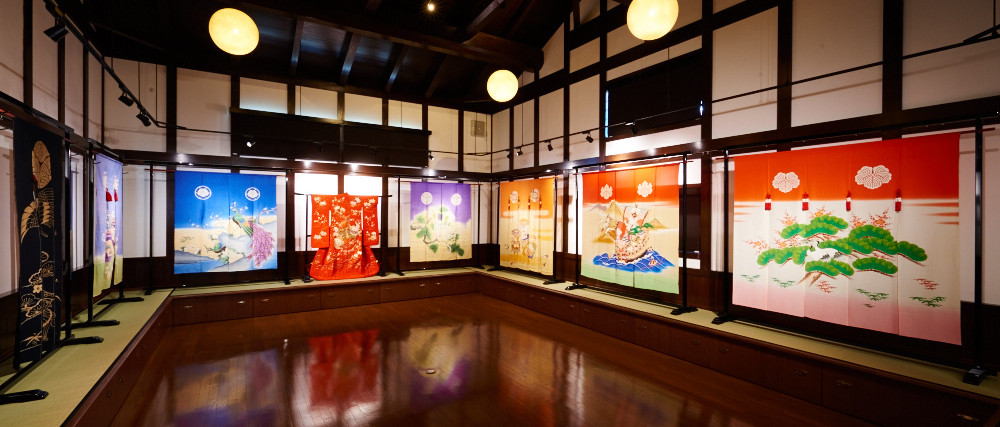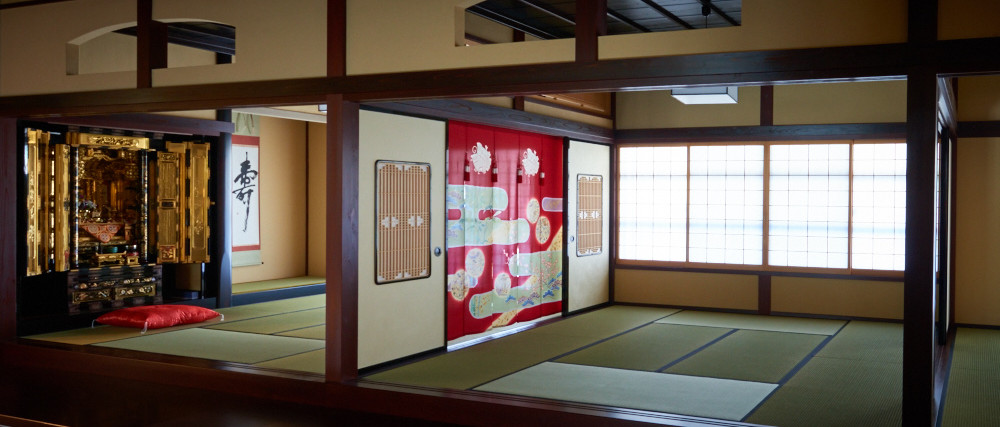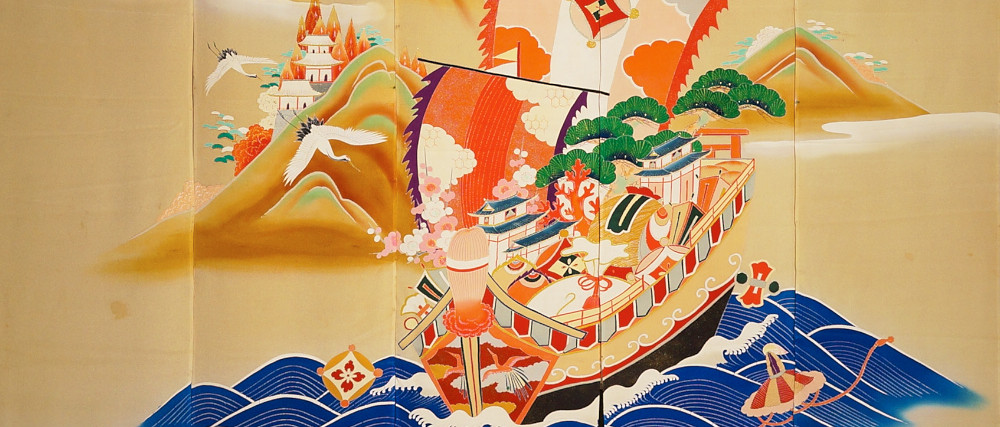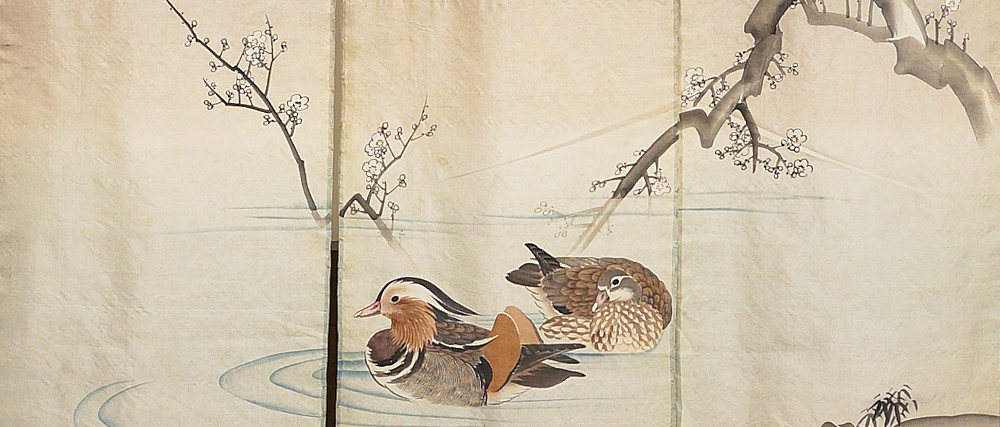

Hanayome Noren Museum (Bridal Curtain Museum)
The Hanayome Noren is a bridal custom started in Noto, Kaga, and Ecchu provinces of the Kaga Domain (Kaga han) going back to the end of the Edo and Meiji periods (19th century). On the occasion of marriage, the curtain is hung at the entrance of the Buddhist alter room in the broom’s house and the bride goes through it.
Once the wedding ceremony is finished, there is usually no opportunity to use the curtain again. For this reason, female managers of shops and restaurants on Ipponsugi-dori (street) started to hold the “Hanayome Noren Exhibition” during the Golden Week (early-May holiday season in Japan) since 2004. The curtains are displayed in shops and houses on the shopping street during the week and attracting large numbers of people.
“Hanayome Noren Museum” was built to enable visitors to look at the curtains all year round. The Museum was opened in the spring of 2016 and curtains from Meiji to Heisei period (late 19th century) are displayed in the permanent exhibition room.
In addition, there are a planned exhibition room that displays the local wedding culture, an experience zone where visitors can dress up in wedding costumes and go through the bridal curtain, a museum shop that sells original goods, and a community space where local sightseeing information is provided.
About Hanayomenoren
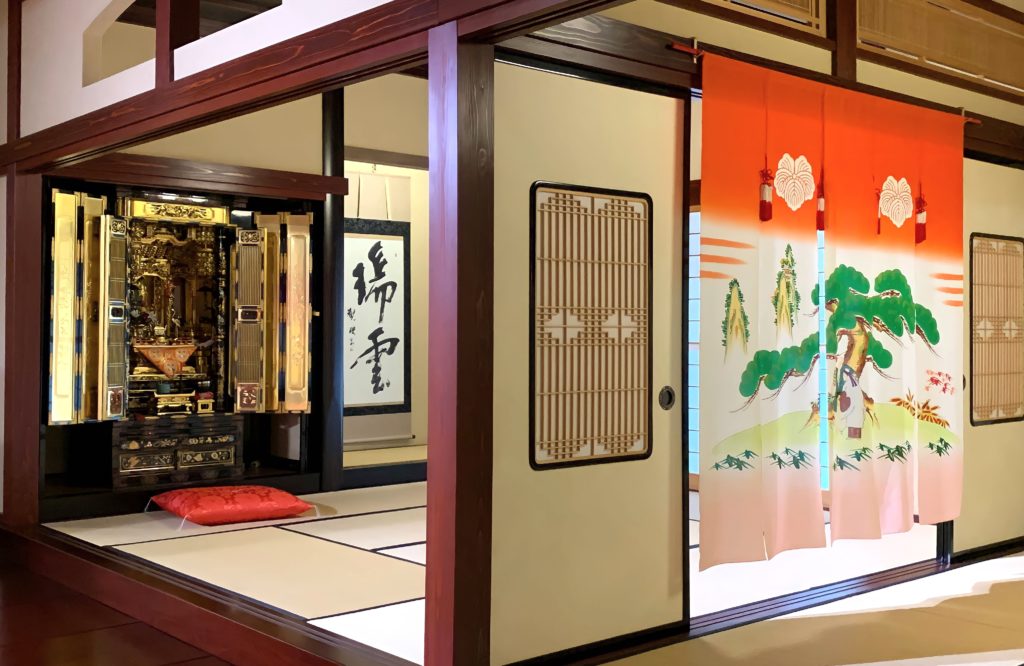
Hanayome Noren: Vibrant Symbols of a Family’s Love
On the Noto Peninsula, brightly colored noren curtains with auspicious motifs have long been a symbol of a bride’s transition to a new life. Until the mid-twentieth century, arranged marriages were the norm. The wedding was usually a small ceremony held at the groom’s home to welcome the bride to her new family. The bride’s mother prepared a decorative hanayome noren (bridal curtain), for the ceremony. It was hung in the groom’s home for the wedding, typically between the living room and the Buddhist altar room, where the marriage ceremony took place. The curtain was a symbol of the affection of the bride’s family and the threshold to her new life.
Hopes for a happy future
The hanayome noren was made as part of the bride’s wedding trousseau of clothing and furnishings delivered to the groom’s family home before the wedding. It was often designed in celebratory colors such as red, pink, and blue, with auspicious motifs such as cranes to represent long life, pairs of mandarin ducks to symbolize a happy union, as well as images representing the bride’s hometown. The bride’s family crest was featured at the top of the curtain; the last time she would use it.
The bride’s mother designed the curtain with her daughter in mind. The bride first saw the curtain as she walked through it, into the altar room to officially join her husband’s family. This one-of-a-kind curtain served as a tangible expression of her mother’s love and hopes for her daughter’s future happiness. It would be displayed for visitors to the groom’s home for a few days after the wedding, then carefully packed away in a drawer, never to be used again.
The tradition started in the late Edo period (1603–1867) and was widely practiced in the Noto, Kaga, and Etchu provinces (present-day Ishikawa and Toyama prefectures) until the mid-twentieth century. The curtains were typically made from cotton, but the most lavish were made of silk, with intricate motifs rendered in Kaga yuzen, a resist-dye technique that developed in the region in the seventeenth century. The multi-step process of Kaga yuzen dyeing requires a high degree of skill, applying delicate linework and shading effects by hand. The curtain could take up to six months to make.

Crossing the threshold to a new life
The permanency of a bride’s transition to her new family was marked by a ceremony at the entrance to the groom’s family home before the marriage ceremony. The bride would mix water from the two households and sip it from a ceramic dish. The dish was then smashed as a gesture that she was leaving her old life behind. For the ceremony, the bride wore a white shiromoku wedding kimono, another symbol of starting afresh.
Stepping through the curtain bearing her family crest and motifs from her hometown, the bride left her old life behind. She would then approach the altar to announce herself to her new family’s ancestors before the marriage ceremony began.
Curtains for grooms
While most curtains were for brides, a hanamuko noren (groom’s curtain) was made when a man was adopted into his wife’s family. In families with only daughters, a son-in-law might take his wife’s name in order to continue her family line. Designs for grooms tended toward cool colors and masculine motifs such as fearsome hawks to represent strength and power, Japanese carp to symbolize overcoming obstacles, and pine trees to represent longevity and steadfastness.
Changing design trends
The designs of hanayome noren were dictated by the bride’s preference while following the fashion trends of the era. The curtains of the late Edo period and Meiji era (1868–1912) were usually printed on cotton, with imagery representing longevity and good fortune. Tortoise and crane motifs were common.
From the twentieth century to the present day, the curtains became more elaborate. Fabrics changed from cotton to silk, and Kaga yuzen dyeing methods were used to make intricate patterns and images with contemporary appeal such as seasonal flowers, or well-known scenery. From 1945, brighter colors became common, as chemical dyes allowed more vivid colors.
The revival of a faded art
From the 1970s, weddings evolved, moving from private ceremonies held in homes to elaborate productions staged at hotels. The transition from the bride’s family to her in-laws’ lost its sense of gravity as more women joined the workforce and gained economic independence. The popularity of the curtains faded, and families ceased to make them when their daughters left home to marry. Interest in these curtains has seen a resurgence in recent years. In 2004, storekeepers along Ipponsugi Dori shopping street in Nanao began exhibiting their family curtains during the annual Golden Week holidays in May. In 2016, Hanayome Norenkan was opened just off the shopping street to display bridal curtains year-round. Some families on the Noto Peninsula continue to use hanayome noren as a way to honor past traditions, albeit without the original sense of finality of cutting family ties by the bride.
This English-language text was created by the Japan Tourism Agency.
Floor Guide
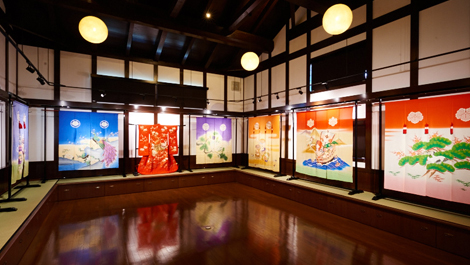 Temporary Exhibition
Temporary ExhibitionApproximately ten bridal curtains from Meiji to Heisei period (19th century-present) are displayed. You can observe the transition of the curtains and distinctive features of each period.
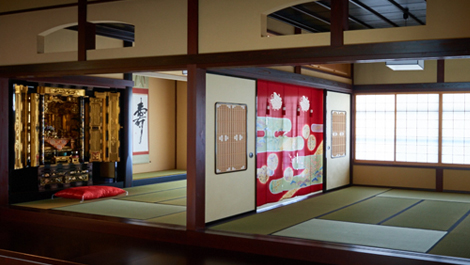 Buddhist alter room & Japanese room
Buddhist alter room & Japanese roomThese rooms represent Buddhist alter rooms of this area using locally made Buddhist Alter (Nanao Buddhist Alter) and fittings (such as sliding doors and shoji screens) (Tatsuruhama tategu). The bridal curtain is hung in the Buddhist alter room and visitors can participate in the Bridal Curtain Experience in this zone.

Noren Gallery
People’s preferences in colours and patterns of the bridal curtain have changed over time. Some of the curtains are made of hemp or cotton, while most others are made of silk using the traditional hand-painting technique called Kaga-Yuzen. In the Museum, you can look at the bridal curtains from Meiji to Heisei period (late 19th century-present) at all times. In all ages, parents’ warmhearted feelings to their marrying daughter are expressed in the bridal curtain. Please enjoy the beauty of traditional Japanese culture which has been handed down in this area.
The Bridal Curtain Experience
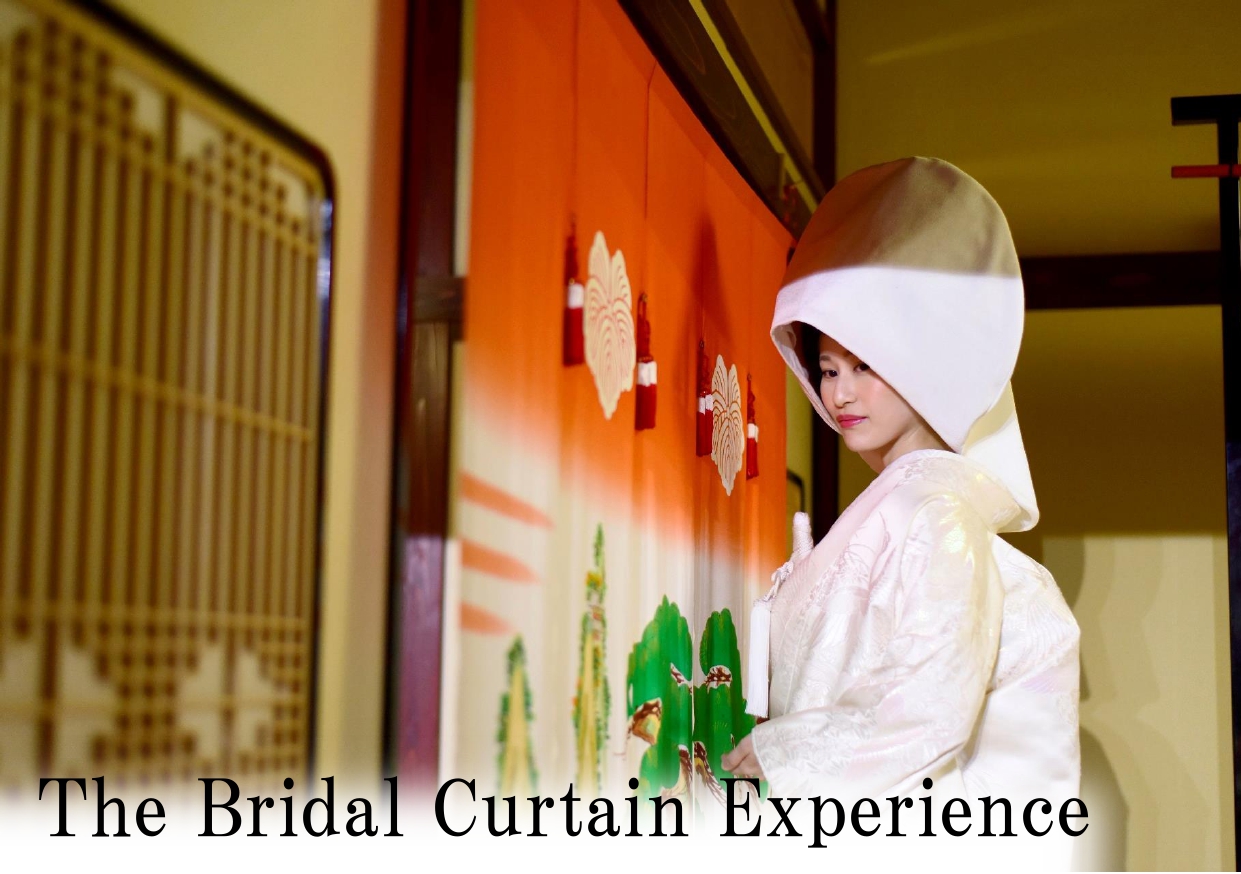
You can try dressing up in Shiromuku (white bridal kimono) or
Uchikake (gorgeously patterned bridal kimono) and go through the bridal curtain.
A couple can enjoy it together as there is a traditional men’s costume
consisting of a crested kimono and a hakama (a pleated and divided Japanese skirt for men) prepared for male visitors too!
Please enjoy it for the memory of your trip.
< Price >
・Women 1piece (Shiromuku or Irouchikake)
¥5,000
・・・・ 2piece(Shiromuku and Irouchikake )
¥7,000
・Men (crested kimono and a hakama) ¥3,000

※This experience is not on discount .
<Experience process>
①Confirm reservation and Payment
↓
②Dressing up
↓
③Going through the formal bridal curtain ※Women only
↓
④Take a photo
↓
End of experience
※ Please do your own make-up.
※ Can’t go outside wearing a kimono.
<Required time & Number of people>
Experience times are 10:00~15:00
Required time : 1 hour~1.5 hours
※Please come here 5~10 minutes earlier than at the time it begins.
<Necessities>
・Camera
・Lipstick ※ Please do your own make-up.
・Wide neck shirt

<For Reservation>
~ 1/31 → Accepting reservations(No reservations available on 12/27
~1/4、1/10、1/13、1/15、1/19)
2/1~ → We will start accepting reservations from mid October.
※ Reservation deadline・・・・・Please apply at least 3 day before the desired date.
Reservation by E-mai : nanaoya_kura@yahoo.co.jp
(Subject : ☆Reservataion Experience☆ )
*The reservation is tentative.
The reservation is confirmed once you receive an E-mail from the secretariat.
If you do not hear from the secretariat within three days, please contact by using a different E-mail address.
Shop
Original goods that are sold only in the Museum and various gift items are found in the museum shop.
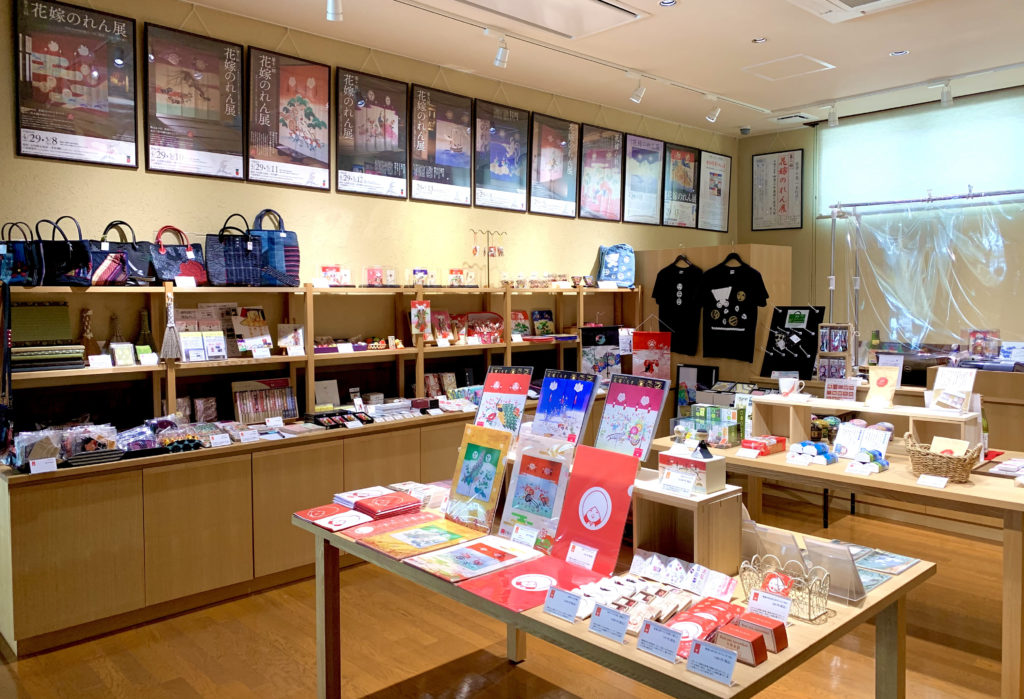
Facility Information
Opening hours & closed days
Opening hours
9:00-17:00 (last entry 16:30)
Closed days
New Year’s holiday (29 Dec.-3 Jan.)
Entrance fee
| High school student and adult | 550 yen |
|---|---|
| Elementary & junior high school student | 250 yen |
| Child | free |
| Group (20 people or more) | 450 yen |
Access
●By train
By the limited express “Noto Kagaribi”, it takes approximately an hour from Kanazawa station to Nanao station. From Nanao station, it is eight minutes’ walk to the Museum.
●By car
It takes approximately 30 minutes from Uwadana-Yada IC of Noto Satoyama Kaido or approximately 10 minutes from Nanao IC of Noetsu Expressway .
Hanayome Noren Museum (Bridal Curtain Museum)
Tsu-bu 49, Madashimachi, Nanao City, Ishikawa, 926-0818, Japan
Tel: +81-767-53-8743
Fax: +81-767-53-8744
URL: www.hanayomenorenkan.jp
E-mail: info@hanayomenorenkan.jp
Enquiries
If you do not receive an e-mail reply within 5 days, please contact by using a different E-mail address.
E-mail: info@hanayomenorenkan.jp



